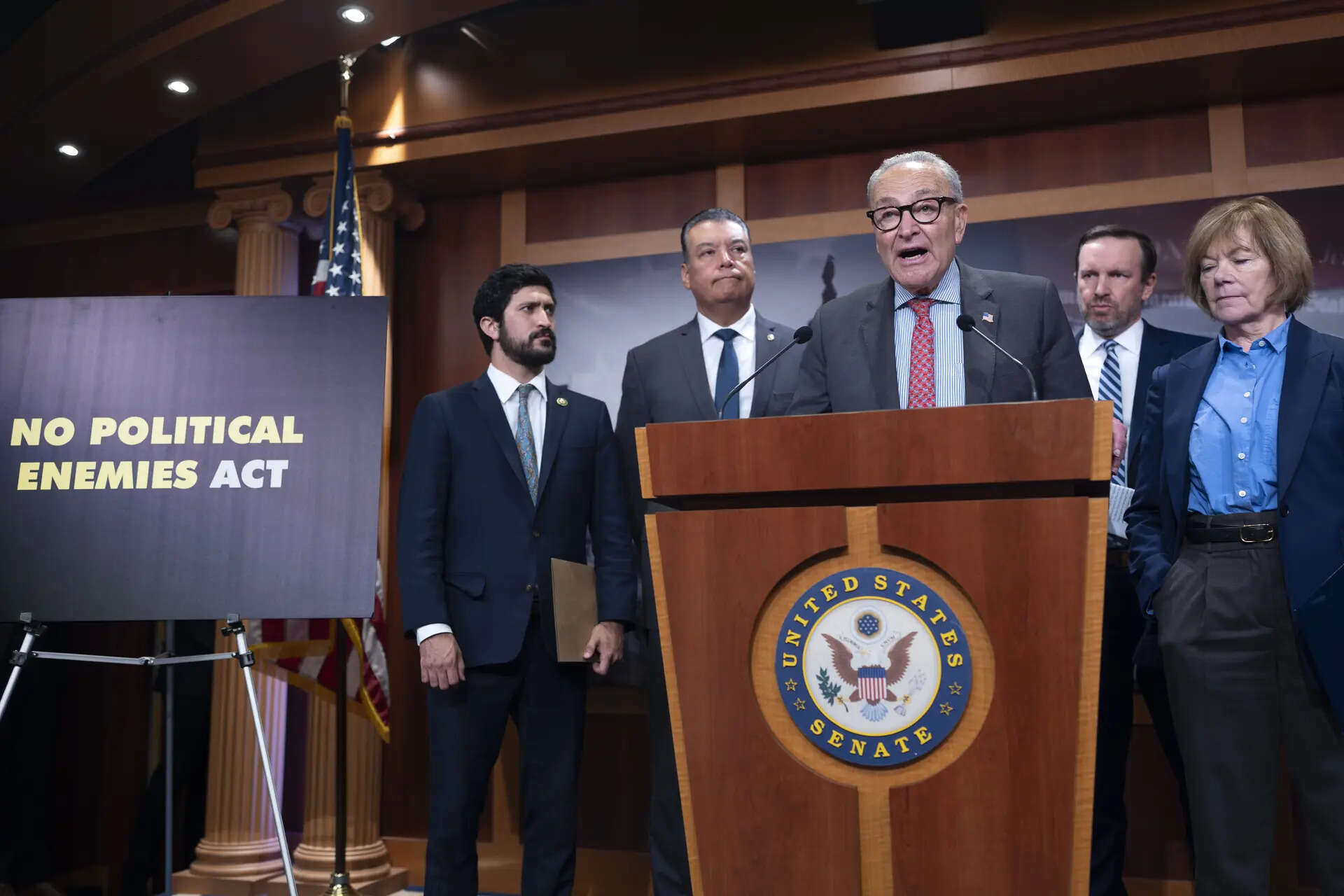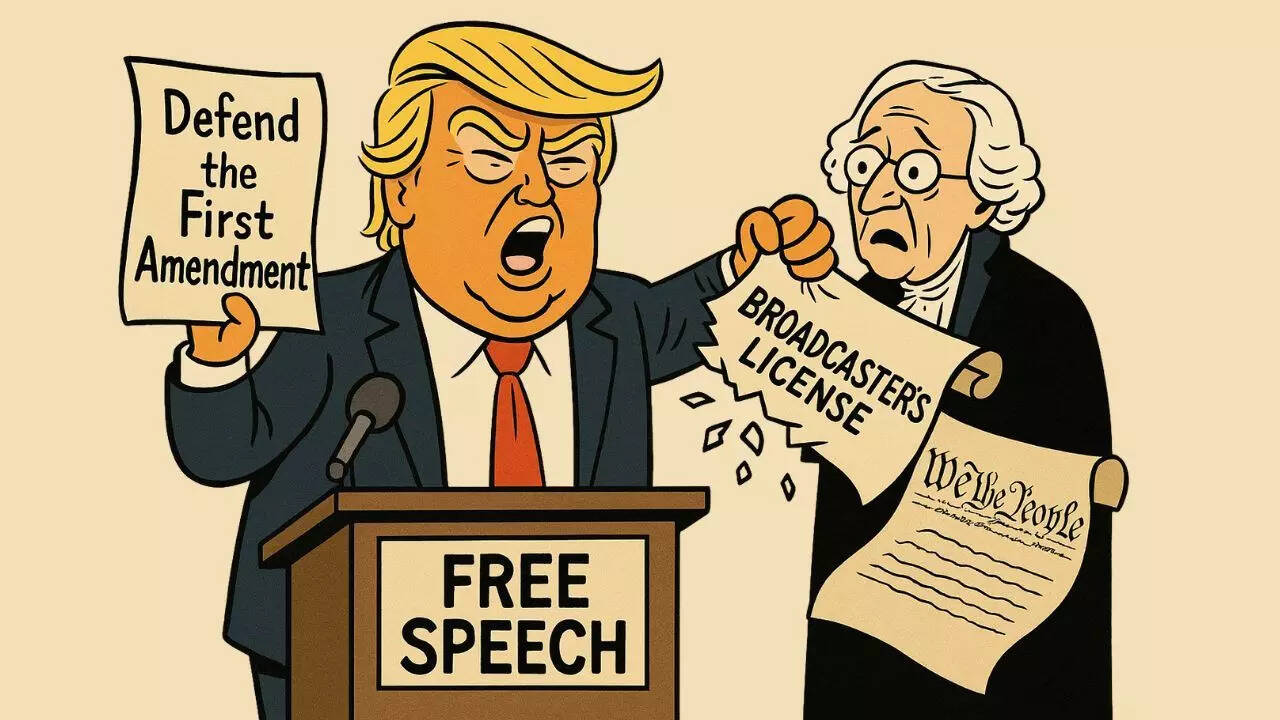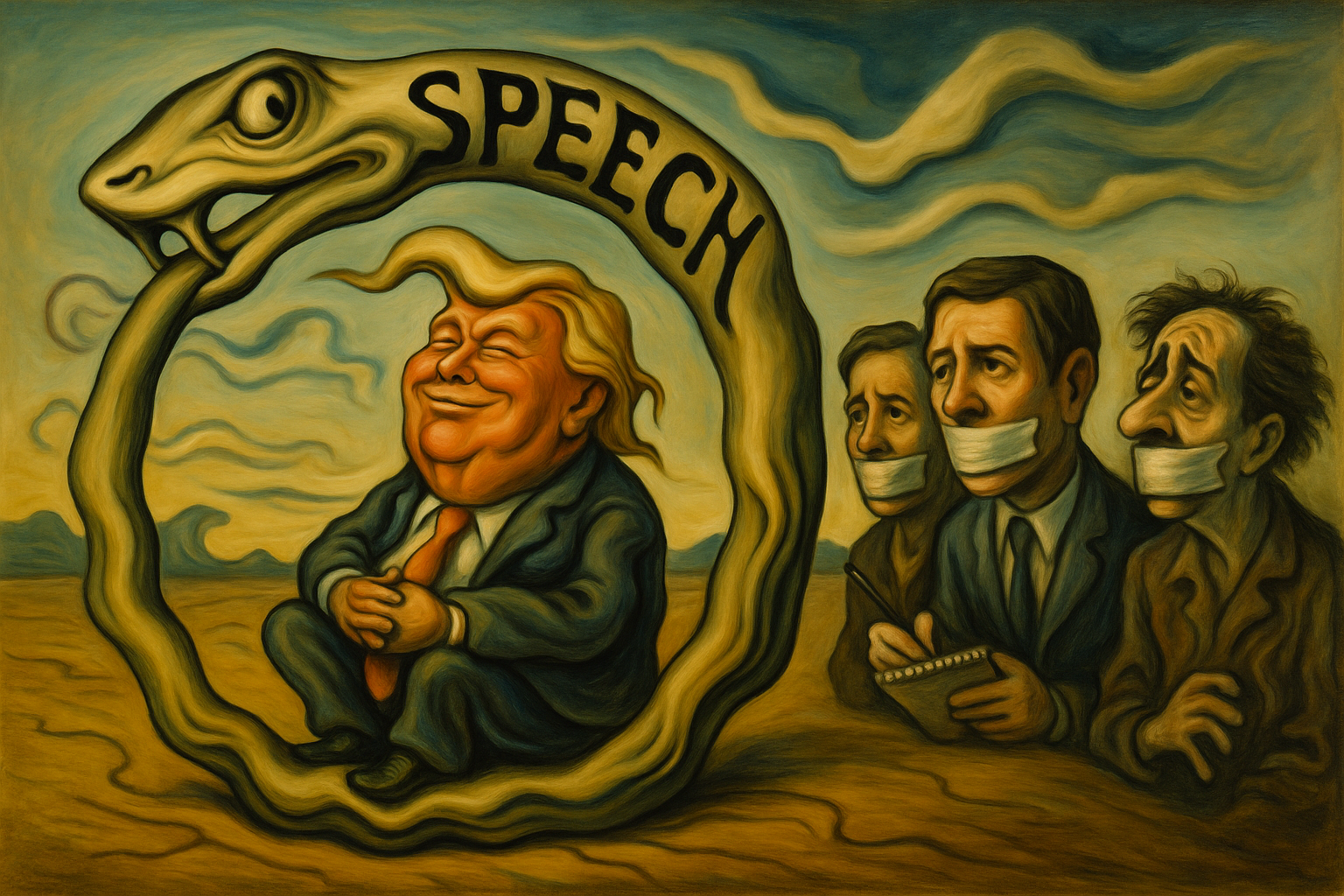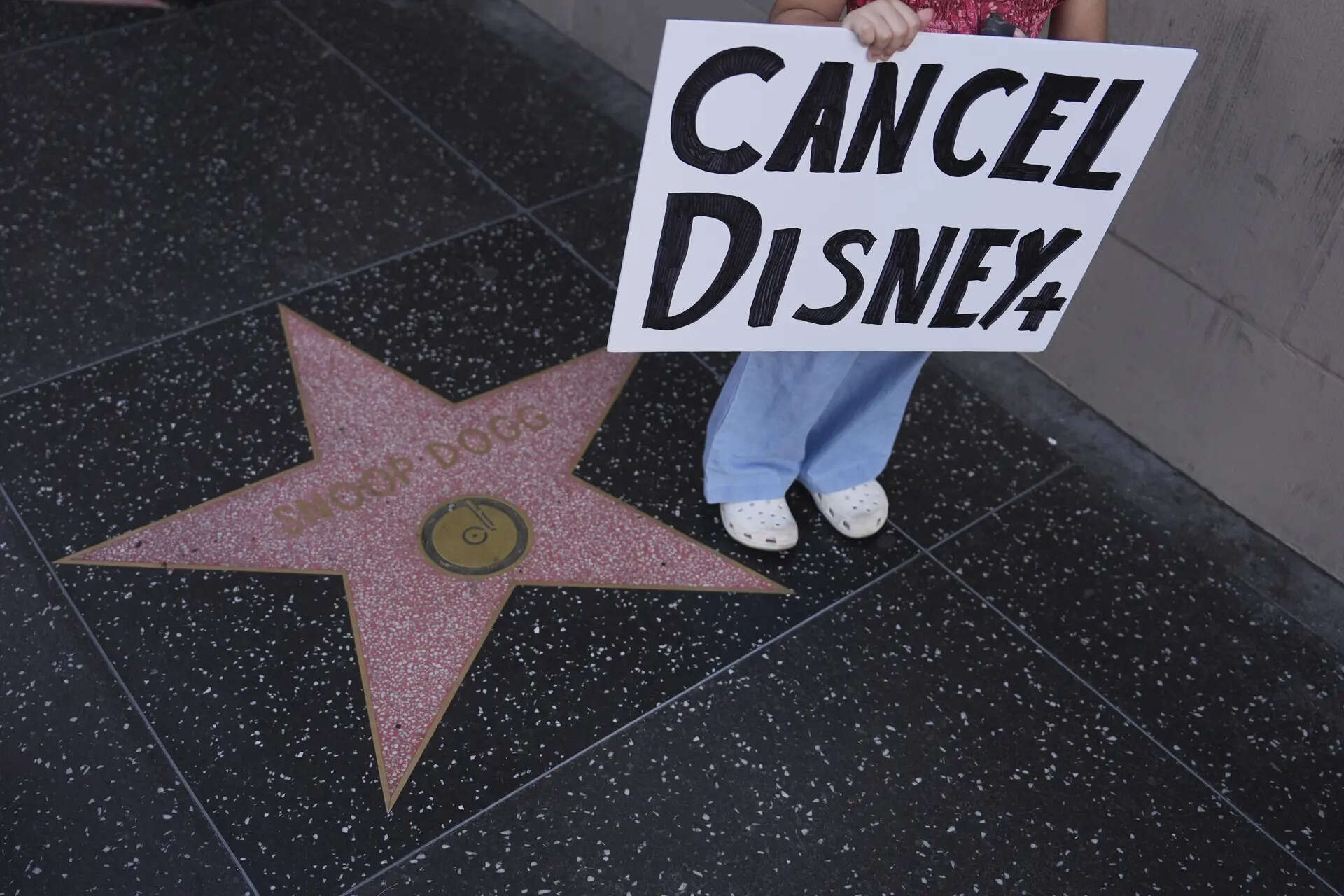When Donald Trump returned to the White House in January 2025, he pledged to “bring back free speech to America,” casting himself as the scourge of cancel culture and the defender of voices silenced by elites. Nine months later, the same president is threatening to strip broadcasters of their licenses, applauding the suspension of a late-night comedian, and urging regulators to punish networks for negative coverage. The man who once promised to end censorship now stands accused of practising it from the Oval Office.
Driving the news
When Donald Trump swept back into the White House in January 2025, he cast himself as the man who would rescue America from “cancel culture.” He promised to dismantle censorship, restore free speech, and end what he described as a coordinated campaign by Democrats and Silicon Valley to muzzle conservatives.Nine months later, his administration is spearheading one of the most aggressive government campaigns against speech in recent American history. From pressuring networks to suspend late-night comedy shows, to floating the revocation of broadcast licenses for critical coverage, Trump’s shift has been swift, personal, and unmistakable.This is more than another partisan fight. It is a story of how the president who branded himself as a free-speech absolutist is now pushing the federal government to punish critics — and why that reversal has shaken Washington.
The promises before 2025

Senate Minority Leader Chuck Schumer, D-N.Y., center, is joined from left by Rep. Greg Casar, D-Texas, Sen. Alex Padilla, D-Calif., Sen. Chris Murphy, D-Conn., and Sen. Tina Smith, D-Minn., as they talk about the First Amendment and free speech after late night talk show comedian Jimmy Kimmel was suspended by ABC indefinitely amid a controversy over his recent comments about Charlie Kirk’s suspected killer, during a news conference at the Capitol in Washington, Thursday, Sept. 18, 2025. (AP Photo/J. Scott Applewhite)
Trump’s free-speech crusade was not invented overnight. During his first presidency and through the years in opposition, he built a political identity around defending Americans’ right to speak freely, even offensively.
- Campaign rhetoric (2016–2020): Trump railed against universities, corporations, and tech companies for “silencing conservatives.” He portrayed himself as the lone defender of ordinary Americans against elite cultural enforcers.
- Executive orders: In 2020, he signed an order targeting Big Tech platforms, declaring that free speech was “the bedrock of American democracy.” His message was simple: Silicon Valley was censoring conservative voices, and the government had to stop it.
- The “cancel culture” theme: Whether it was comedians losing contracts, academics fired for controversial research, or conservative activists booted from Twitter, Trump made each case a rallying cry. Cancel culture, he argued, was un-American.
When he returned to power in 2025, his inaugural address doubled down. “We will stop all government censorship and bring back free speech to America,” he thundered. Within weeks, he issued a fresh executive order instructing agencies to ensure no federal employee “would unconstitutionally abridge the free speech of any American citizen.”At that point, the through line seemed consistent: Trump the defender of speech, the scourge of censorship.
The reversal after returning to power

By September 2025, that stance had all but collapsed. Several developments marked the break.1. License threats against broadcasters: On Air Force One, Trump suggested that broadcasters who air negative coverage should “maybe” lose their licenses. He singled out networks like ABC and NBC, accusing them of being partisan and unfair.2. The Jimmy Kimmel affair: After ABC suspended comedian Jimmy Kimmel’s late-night show under regulatory pressure, Trump praised the decision and urged the FCC to go further. Kimmel’s crime, in the president’s eyes, was making jokes about conservative activist Charlie Kirk after his assassination.3. Weaponising the FCC: Brendan Carr, Trump’s handpicked FCC chairman, has spoken openly about scrutinising networks that air critical commentary. He has suggested broadcasters have a duty to serve “the public interest” — language that, under Trump, now means avoiding sustained criticism of the president.4. Targeting critics as extremists: The administration has floated plans to strip liberal groups of tax status, monitor online speech, and even designate certain organisations as domestic terrorists if they are seen to encourage “hate speech.”Together, these moves show a White House willing to use federal levers to silence or intimidate voices that once would have been protected.Why it mattersThe shift is not merely rhetorical. Trump has moved from denouncing cancel culture to practising it, with the difference that his tools are not private boycotts or corporate decisions, but the power of the state.
- Legal stakes: The
First Amendment has long been interpreted to prohibit the government from punishing speech simply because it is critical. If the FCC were to revoke licenses for negative coverage, it would face immediate constitutional challenges. - Political stakes: Trump’s threats play to his base, which sees mainstream networks as hopelessly biased. But they also risk alienating traditional conservatives who value limited government and fear precedents that could one day be used against them.
- Cultural stakes: The administration’s turn blurs the line between fighting misinformation and punishing dissent. Critics warn it could normalise government pressure on media companies, a hallmark of authoritarian states.
The voices of warning
The backlash has been swift, from across the political spectrum.
- Democrats: Lawmakers have accused Trump of “abuse of power” and are pushing legislation to strengthen protections for media outlets. They argue the FCC cannot constitutionally act as a speech police.
- Obama: The former president accused Trump of hypocrisy, saying that after years of complaining about cancel culture, his administration had taken it to a “new and dangerous level.”
- Republican unease: Not all conservatives are comfortable. Tucker Carlson, while sympathetic to Trump’s broader agenda, warned that introducing “hate speech” laws would cross a line and demanded civil disobedience if speech policing went further.
- JD Vance: The vice president has faced awkward questions. He once argued that offensive posts should not ruin lives and urged Europeans to stop isolating far-right parties in the name of free speech. Now, he has been notably muted as the administration threatens critics.
The big picture
Trump’s pre-2025 record shows a president who framed himself as a free-speech warrior, railing against censorship. His post-2025 record reveals a leader using federal power to punish critics and reshape media behaviour. The contradiction exposes a core tension in Trump’s politics: free speech is defended when it benefits him, but challenged when it cuts against him.
The hypocrisy problem

The most striking part of this U-turn is how openly contradictory it is. Trump’s team once mocked Democrats for leaning on social media companies to flag misinformation, calling it “censorship by proxy.” Now, they are exerting direct pressure on broadcasters.During his campaign, Trump’s rallying cry was: let Americans speak freely, even if it offends. Today, he justifies punishing speech that offends him. What he once denounced as cancel culture, he now embraces as governing strategy.This is not just political theatre; it is a test of constitutional boundaries. And it is happening at a time of heightened polarisation, when both sides accuse the other of weaponising speech rules.
A timeline of the flip
Before 2025
- 2016–2020: Attacks universities and Big Tech for censoring conservatives.
- 2020: Signs executive order declaring free speech “bedrock of democracy.”
- 2025 January: Inaugural vow to “stop all government censorship.”
After 2025
- February–April: Executive order reaffirming no government employee should abridge speech.
- August: Begins attacking networks, calling them “97% negative.”
- September: Suggests FCC revoke licenses of critical broadcasters.
- September: Applauds ABC for suspending Jimmy Kimmel, urges more scrutiny.
- Autumn: Administration floats monitoring speech, tax penalties for liberal groups.
The bottom line

A demonstrator holds a sign reading “CANCEL DISNEY+” outside El Capitan Entertainment Centre, where the late-night show “Jimmy Kimmel Live!” is staged, Thursday, Sept. 18, 2025, in Los Angeles. (AP Photo/Jae C. Hong)
Trump’s second presidency has produced one of the most dramatic reversals in modern political memory: from a man who made “free speech” his battle cry, to one who openly contemplates stripping critics of their platforms.The contradiction is not lost on Americans. For his supporters, punishing hostile networks is fair retaliation after years of bias. For his critics, it is proof that Trump’s rhetoric on free speech was never about principle — only about power.Either way, the U-turn has reshaped the debate over speech in America. What was once a fight against cancel culture has now become a contest over whether the government itself will become the arbiter of what Americans can watch, hear, and say.

